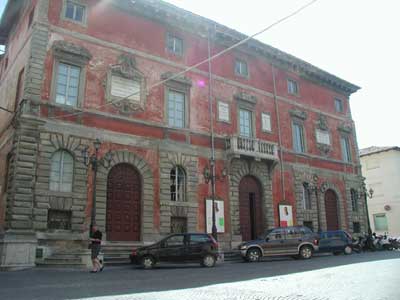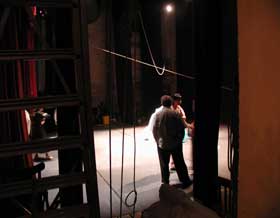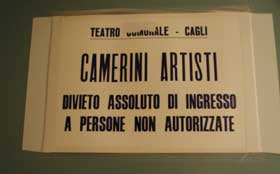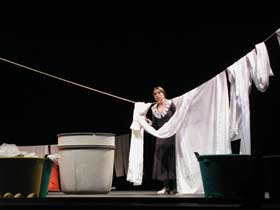

![]() "È posible," replied Simonetta Paolucci, president of L'Accademia del Teatro, after
I requested permission to take photos backstage at the opera, La Serva Padrona. I
had the option of the dress rehearsal or no backstage photos. She explained that my presence
would be a distraction during an actual performance. I was excited, regardless of the
restrictions: I could not use flash, I had to attend alone, and I must be inobtrusive.
"È posible," replied Simonetta Paolucci, president of L'Accademia del Teatro, after
I requested permission to take photos backstage at the opera, La Serva Padrona. I
had the option of the dress rehearsal or no backstage photos. She explained that my presence
would be a distraction during an actual performance. I was excited, regardless of the
restrictions: I could not use flash, I had to attend alone, and I must be inobtrusive.
![]() Arriving at the
Teatro Comunale around six o'clock, I skip the grandeur of the
main entrance and enter through the side door. For a brief moment, I see
the theater through the eyes of a performer. I am not visiting the theater
as a tourist or a member of the audience; rather I am a professional with
a task at hand. In a way it was my opportunity to perform.
Arriving at the
Teatro Comunale around six o'clock, I skip the grandeur of the
main entrance and enter through the side door. For a brief moment, I see
the theater through the eyes of a performer. I am not visiting the theater
as a tourist or a member of the audience; rather I am a professional with
a task at hand. In a way it was my opportunity to perform.
![]() I enter the auditorium
as orchestra members arrived. The cozy theater seems to glow. Sunlight
seeps through the open doors. Four stage lights point their beams to where
the action would soon take place. Atop a sea of music stands, light sparkles
like several swarming fireflies. I hear nothing other than the hum of
tuning strings, not yet unified by Maestro Shih-Hung Young's waving baton.
I enter the auditorium
as orchestra members arrived. The cozy theater seems to glow. Sunlight
seeps through the open doors. Four stage lights point their beams to where
the action would soon take place. Atop a sea of music stands, light sparkles
like several swarming fireflies. I hear nothing other than the hum of
tuning strings, not yet unified by Maestro Shih-Hung Young's waving baton.
![]() I snap pictures
of musicians as they assemble their instruments, gently resting violins
upon their shoulders. I move closer to the pit. The maestro stands atop
his raised podium, reviewing his lines of music painted with blue and
pink highlighter.
I snap pictures
of musicians as they assemble their instruments, gently resting violins
upon their shoulders. I move closer to the pit. The maestro stands atop
his raised podium, reviewing his lines of music painted with blue and
pink highlighter.
![]() Noise and movement
off stage spark my curiosity. I quickly move through a door with a sign
explaining something in Italian that I understood to mean the public is
not welcome. I walk through the door. Behind the scenes, I hear one of
the choreographers call to Rena Granieri, who is playing Serpina in La
Serva Padrona. I sense I am in the way and step aside. I begin shooting
on-stage action. Donato DiGioia, Umberto in the performance tomorrow,
is ready to jump into his on-stage bathtub and motions for me NOT to take
his photo. He is wearing only white boxer shorts. It is shocking. I can
only assume he will be wearing more clothing at tomorrow night's performance.
Unsure whether he understands why I am present, I fib and motion that
I am only focusing and will wait until he is fully submerged, decent,
and begins singing. But I had wanted to capture the moment on film.
Noise and movement
off stage spark my curiosity. I quickly move through a door with a sign
explaining something in Italian that I understood to mean the public is
not welcome. I walk through the door. Behind the scenes, I hear one of
the choreographers call to Rena Granieri, who is playing Serpina in La
Serva Padrona. I sense I am in the way and step aside. I begin shooting
on-stage action. Donato DiGioia, Umberto in the performance tomorrow,
is ready to jump into his on-stage bathtub and motions for me NOT to take
his photo. He is wearing only white boxer shorts. It is shocking. I can
only assume he will be wearing more clothing at tomorrow night's performance.
Unsure whether he understands why I am present, I fib and motion that
I am only focusing and will wait until he is fully submerged, decent,
and begins singing. But I had wanted to capture the moment on film.
![]() Moving behind a
ladder I assume leads to a catwalk, I stay out of sight. I covertly snap
his picture and climb a short set of marble steps to the mezzanine. Sitting
in my personal box seat gives me another vantage point of the performance.
I can see the pianist, Mirca Rosciano, who sits in a box closest to the
stage. Opposite her are two technicians in charge of the curtain and lighting.
Between them, covering the area just below the apron, are the vibrating
bows of the orchestra.
Moving behind a
ladder I assume leads to a catwalk, I stay out of sight. I covertly snap
his picture and climb a short set of marble steps to the mezzanine. Sitting
in my personal box seat gives me another vantage point of the performance.
I can see the pianist, Mirca Rosciano, who sits in a box closest to the
stage. Opposite her are two technicians in charge of the curtain and lighting.
Between them, covering the area just below the apron, are the vibrating
bows of the orchestra.
![]() Listening to Rena's
soprano, I am awestruck. Here I am in Italy, listening to my very own
opera, single tear makes its way down my cheek. I had not expected to
be moved. Even though the lyrics make no sense to me, they are striking.
The baritono brillante or bass baritone's strong, deep rumble interrupts
her sweet song and I begin to understand the story. Remembering I have
a job to do I leave my box seat, Olympus Camedia in hand, I quietly close
the door and continue on my mission to capture the opera on film.
Listening to Rena's
soprano, I am awestruck. Here I am in Italy, listening to my very own
opera, single tear makes its way down my cheek. I had not expected to
be moved. Even though the lyrics make no sense to me, they are striking.
The baritono brillante or bass baritone's strong, deep rumble interrupts
her sweet song and I begin to understand the story. Remembering I have
a job to do I leave my box seat, Olympus Camedia in hand, I quietly close
the door and continue on my mission to capture the opera on film.
Photos by Julie Ryder, Graphic Design by Ethan Tangerini, Design Production by Emily DePietro and Julie Ryder




Cagli Home Page